Italy: Florence Part 12 - Walking In The Rain
Aug 1, 2023 15:42:41 #
The rain started early in the morning of our net day in Florence and despite the discomfort, lessened the crowds and provided some incredible street scenes. Fortunately we were spared the flooding suffered by Emilia Romagna to the north and on the other side of the Appienne Mountains. We walked from our hotel on the north bank of the Arno, across the Ponte Alle Grazie to the south bank and then back to the north bank across the Ponte Santa Trinita.
I used a plastic rain protector for my camera and kept it inside my rain jacket while we walked. Some shots were taken one-handed while holding an umbrella in the other hand.
I love old bridges so I've included some historical narrative on the 2 we crossed during this walk.
Ponte alle Grazie is a bridge, reconstructed after 1945, over the Arno River in Florence, region of Tuscany, Italy.
History
The original bridge was called Ponte di Rubaconte after the name of the podestà Rubaconte da Mandello who had commissioned construction in 1227, making it older than the Ponte Vecchio. It was rebuilt in 1345 with nine arches, making it the longest in Florence. Giorgio Vasari attributed the design to an architect by the name of Lapo Tedesco, the architect of the Bargello.
In 1346, two of the arches in the Oltrarno neighborhood were filled up to extend the bank, leaving the seven arch structure seen in a 17th-century print on this page. This landfill widened the street of Piazza dei Mozzi, which leads to the Palazzo Mozzi.
On the city side was a small oratory with an icon of the Madonna Alle Grazie, which also gave the bridge its name. Structures were erected at each of the pylons, and remained there till a widening of the road, to make way for railway track. These structures initially were either chapels, once dedicated to Saints Catherine of Alexandria, Barbara, and Lawrence; or erected as huts for female hermits or Romite. These women, wishing to avoid the scandals of some of the nunneries in the city, were said to have immured themselves here, receiving their food from passersby through small slots. These hermitages were ultimately cleared and the remaining women moved to a convent near Santa Croce, renamed the Murate, or Immured. The houses became dwellings until cleared in the 1870s.
In August 1944, the bridge was destroyed by the retreating Germans as they withdrew before the advancing Allied forces in World War II. Following the end of the War, a competition was held to create a new design for a replacement bridge. The winning design, the work of a group formed of architects including Giovanni Michelucci, Edoardo Said, Edoardo Detti, Riccardo Gizdolich and Danilo Know and an engineer, Piero Melucci, feature four slender piers with thin arches between them. The new bridge was completed in 1953. While the new design is harmonious with the surrounding city, its modern design and construction materials do not mirror the shape of the prior bridge.
https://en.wikipedia.org/wiki/Ponte_alle_Grazie
Ponte Santa Trinita
The Ponte Santa Trìnita (Italian for Holy Trinity Bridge, named for the ancient church in the nearest stretch of via de' Tornabuoni) is a Renaissance bridge in Florence, Italy, spanning the Arno. The Ponte Santa Trìnita is the oldest elliptic arch bridge in the world, characterised by three flattened ellipses. The outside spans each measure 29 m (95 ft) with the centre span being 32 m (105 ft) in length. The two neighbouring bridges are the Ponte Vecchio, to the east, and the Ponte alla Carraia to the west.
The bridge was constructed by the Florentine architect Bartolomeo Ammannati from 1567 to 1569. Its site, downstream of the Ponte Vecchio, is a major link in the medieval street plan of Florence, which has been bridged at this site since the 13th century. The wooden bridge of 1252 was swept away in a flood seven years later and was rebuilt in stone; this structure was in turn destroyed by a flood in 1333. The bridge of five arches constructed by Taddeo Gaddi was also destroyed in the flood of 1557, which occasioned Ammannati's replacement. Four ornamental statues of the Seasons were added to the bridge in 1608, as part of the wedding celebrations of Cosimo II de' Medici with Maria Magdalena of Austria: Spring by Pietro Francavilla, Summer and Autumn by Giovanni Caccini, and Winter by Taddeo Landini.
On the night between 3-4 August 1944, the bridge was destroyed by retreating German troops on the advance of the British 8th Army. A Bailey bridge was built for temporary use by the Royal Engineers. The bridge was reconstructed in 1958 with original stones raised from the Arno or taken from the same quarry of Boboli gardens, under the direction of architect Riccardo Gizdulich, who examined florentine archives, and engineer Emilio Brizzi. The missing head of Primavera (Spring) was recovered from the bed of the Arno in October 1961.
https://en.wikipedia.org/wiki/Ponte_Santa_Trinita
For narratives on Florence and additional images, please see my previous posts:
https://www.uglyhedgehog.com/t-780452-1.html
https://www.uglyhedgehog.com/t-780574-1.html#14042094
https://www.uglyhedgehog.com/t-780644-1.html
https://www.uglyhedgehog.com/t-780747-1.html#14046442
https://www.uglyhedgehog.com/t-780857-1.html
https://www.uglyhedgehog.com/t-781066-1.html#14052114
https://www.uglyhedgehog.com/t-781155-1.html
https://www.uglyhedgehog.com/t-781361-1.html
https://www.uglyhedgehog.com/t-781570-1.html#14062411
https://www.uglyhedgehog.com/t-781764-1.html#14066381
https://www.uglyhedgehog.com/t-781877-1.html#14068369
I hope you enjoy these!
Mark
I used a plastic rain protector for my camera and kept it inside my rain jacket while we walked. Some shots were taken one-handed while holding an umbrella in the other hand.
I love old bridges so I've included some historical narrative on the 2 we crossed during this walk.
Ponte alle Grazie is a bridge, reconstructed after 1945, over the Arno River in Florence, region of Tuscany, Italy.
History
The original bridge was called Ponte di Rubaconte after the name of the podestà Rubaconte da Mandello who had commissioned construction in 1227, making it older than the Ponte Vecchio. It was rebuilt in 1345 with nine arches, making it the longest in Florence. Giorgio Vasari attributed the design to an architect by the name of Lapo Tedesco, the architect of the Bargello.
In 1346, two of the arches in the Oltrarno neighborhood were filled up to extend the bank, leaving the seven arch structure seen in a 17th-century print on this page. This landfill widened the street of Piazza dei Mozzi, which leads to the Palazzo Mozzi.
On the city side was a small oratory with an icon of the Madonna Alle Grazie, which also gave the bridge its name. Structures were erected at each of the pylons, and remained there till a widening of the road, to make way for railway track. These structures initially were either chapels, once dedicated to Saints Catherine of Alexandria, Barbara, and Lawrence; or erected as huts for female hermits or Romite. These women, wishing to avoid the scandals of some of the nunneries in the city, were said to have immured themselves here, receiving their food from passersby through small slots. These hermitages were ultimately cleared and the remaining women moved to a convent near Santa Croce, renamed the Murate, or Immured. The houses became dwellings until cleared in the 1870s.
In August 1944, the bridge was destroyed by the retreating Germans as they withdrew before the advancing Allied forces in World War II. Following the end of the War, a competition was held to create a new design for a replacement bridge. The winning design, the work of a group formed of architects including Giovanni Michelucci, Edoardo Said, Edoardo Detti, Riccardo Gizdolich and Danilo Know and an engineer, Piero Melucci, feature four slender piers with thin arches between them. The new bridge was completed in 1953. While the new design is harmonious with the surrounding city, its modern design and construction materials do not mirror the shape of the prior bridge.
https://en.wikipedia.org/wiki/Ponte_alle_Grazie
Ponte Santa Trinita
The Ponte Santa Trìnita (Italian for Holy Trinity Bridge, named for the ancient church in the nearest stretch of via de' Tornabuoni) is a Renaissance bridge in Florence, Italy, spanning the Arno. The Ponte Santa Trìnita is the oldest elliptic arch bridge in the world, characterised by three flattened ellipses. The outside spans each measure 29 m (95 ft) with the centre span being 32 m (105 ft) in length. The two neighbouring bridges are the Ponte Vecchio, to the east, and the Ponte alla Carraia to the west.
The bridge was constructed by the Florentine architect Bartolomeo Ammannati from 1567 to 1569. Its site, downstream of the Ponte Vecchio, is a major link in the medieval street plan of Florence, which has been bridged at this site since the 13th century. The wooden bridge of 1252 was swept away in a flood seven years later and was rebuilt in stone; this structure was in turn destroyed by a flood in 1333. The bridge of five arches constructed by Taddeo Gaddi was also destroyed in the flood of 1557, which occasioned Ammannati's replacement. Four ornamental statues of the Seasons were added to the bridge in 1608, as part of the wedding celebrations of Cosimo II de' Medici with Maria Magdalena of Austria: Spring by Pietro Francavilla, Summer and Autumn by Giovanni Caccini, and Winter by Taddeo Landini.
On the night between 3-4 August 1944, the bridge was destroyed by retreating German troops on the advance of the British 8th Army. A Bailey bridge was built for temporary use by the Royal Engineers. The bridge was reconstructed in 1958 with original stones raised from the Arno or taken from the same quarry of Boboli gardens, under the direction of architect Riccardo Gizdulich, who examined florentine archives, and engineer Emilio Brizzi. The missing head of Primavera (Spring) was recovered from the bed of the Arno in October 1961.
https://en.wikipedia.org/wiki/Ponte_Santa_Trinita
For narratives on Florence and additional images, please see my previous posts:
https://www.uglyhedgehog.com/t-780452-1.html
https://www.uglyhedgehog.com/t-780574-1.html#14042094
https://www.uglyhedgehog.com/t-780644-1.html
https://www.uglyhedgehog.com/t-780747-1.html#14046442
https://www.uglyhedgehog.com/t-780857-1.html
https://www.uglyhedgehog.com/t-781066-1.html#14052114
https://www.uglyhedgehog.com/t-781155-1.html
https://www.uglyhedgehog.com/t-781361-1.html
https://www.uglyhedgehog.com/t-781570-1.html#14062411
https://www.uglyhedgehog.com/t-781764-1.html#14066381
https://www.uglyhedgehog.com/t-781877-1.html#14068369
I hope you enjoy these!
Mark
Gail with the Ponte alle Grazi in the background.
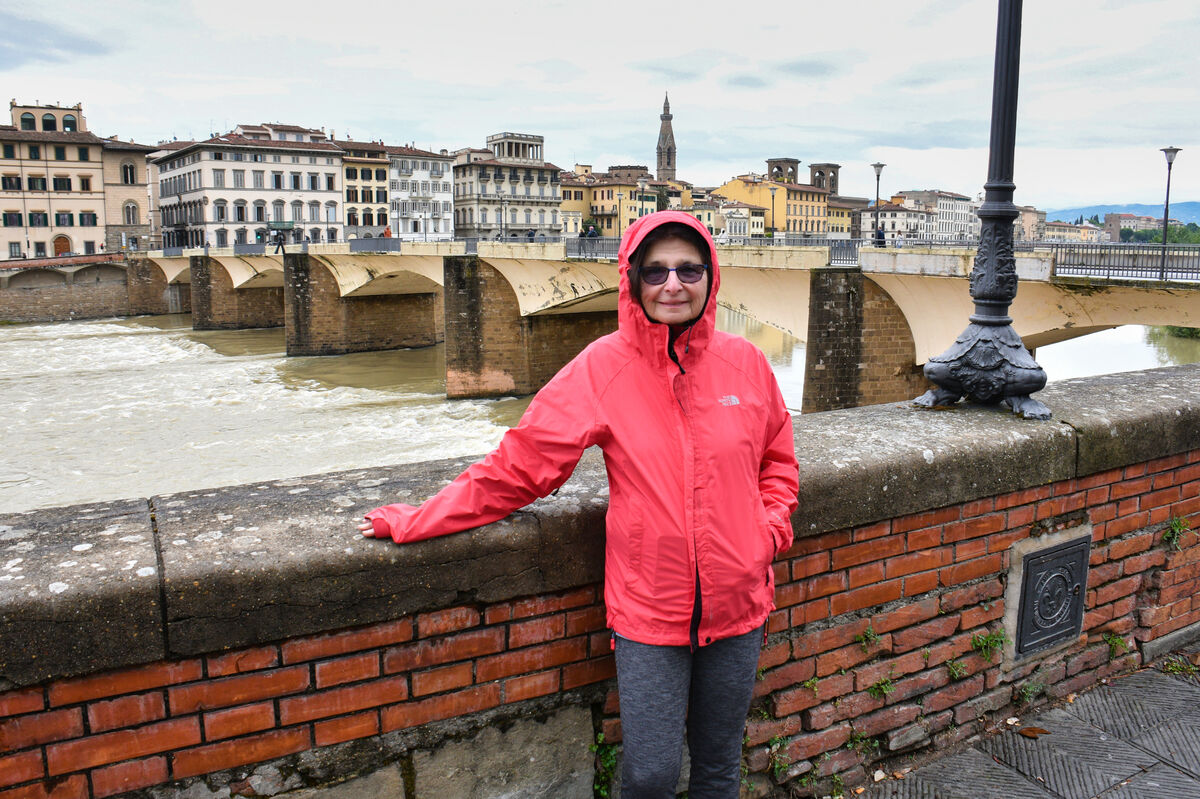
(Download)

(Download)

(Download)

(Download)

(Download)

(Download)
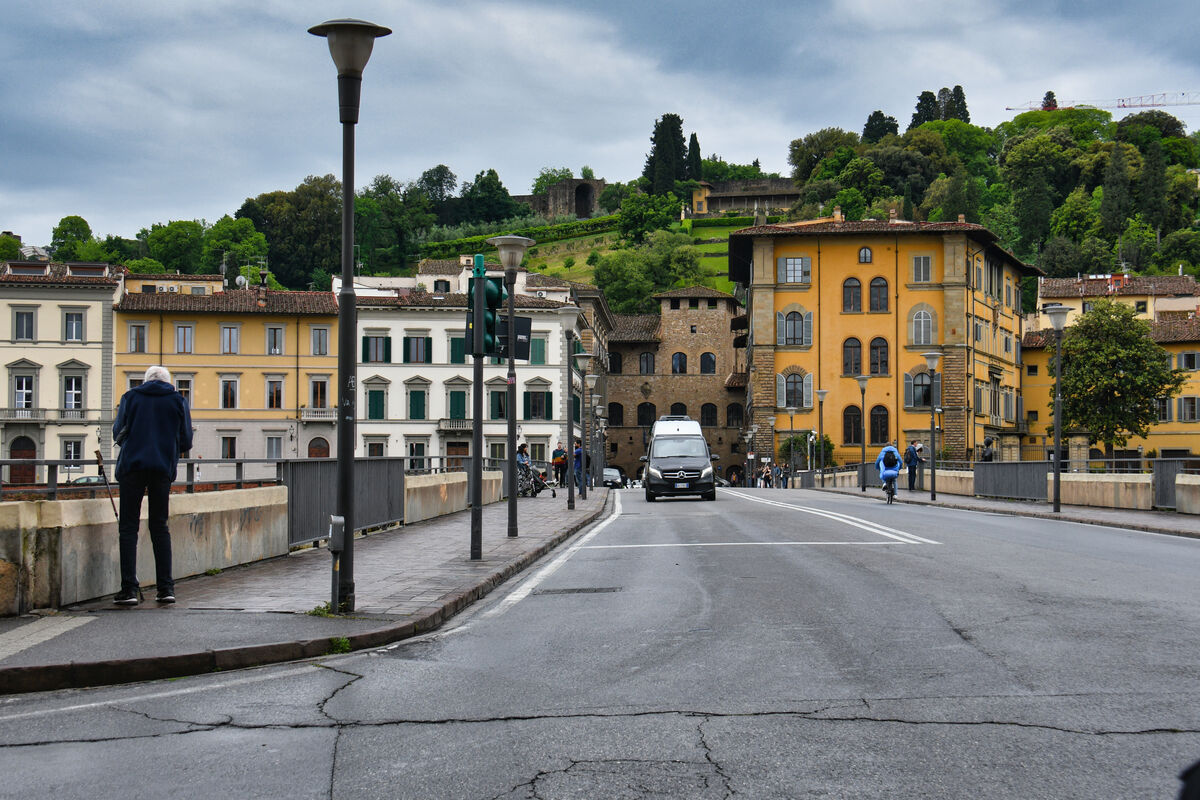
(Download)
From the middle of the bridge looking east
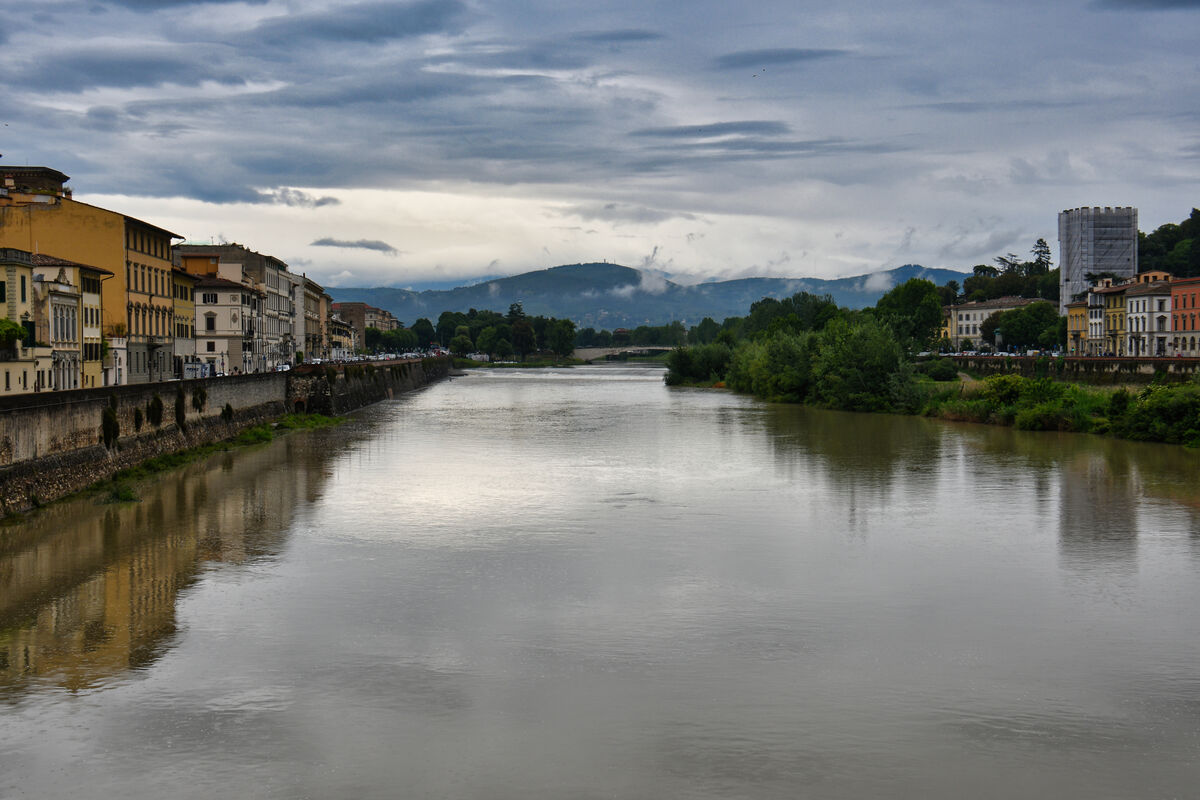
(Download)
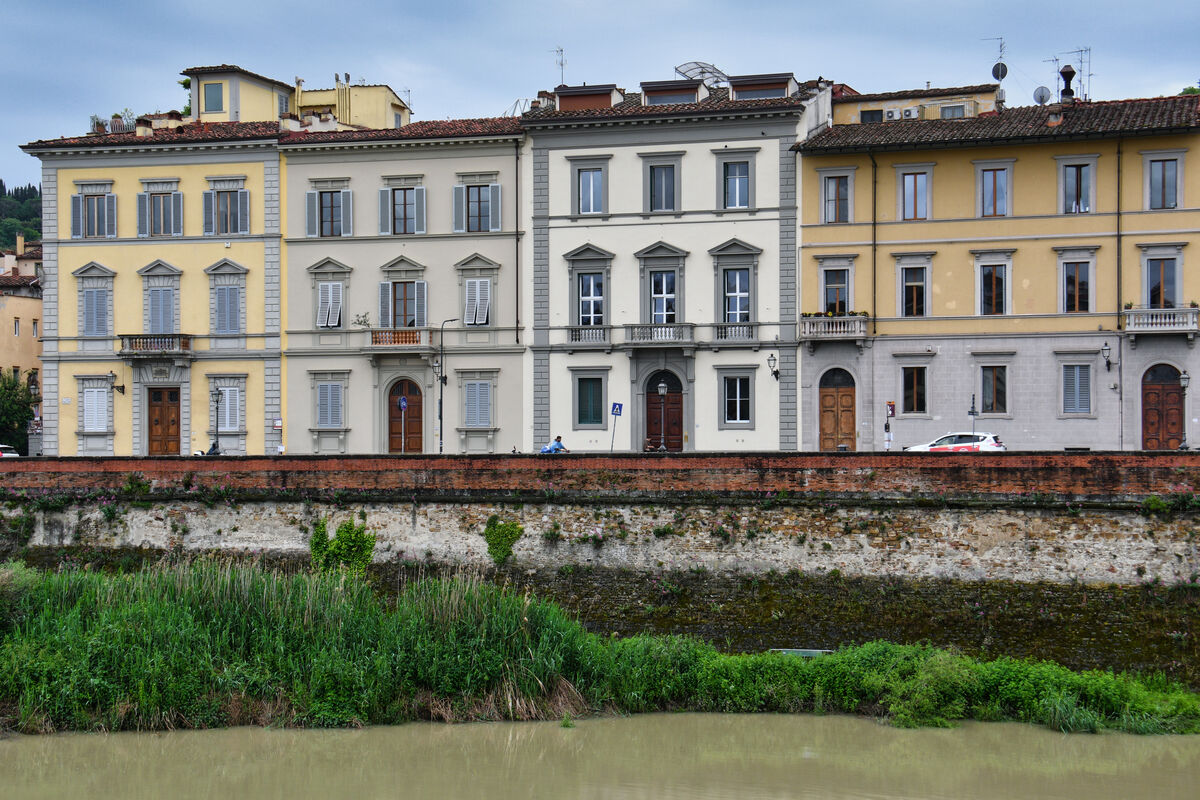
(Download)
In the middle of the bridge looking west at the Ponte Vecchio
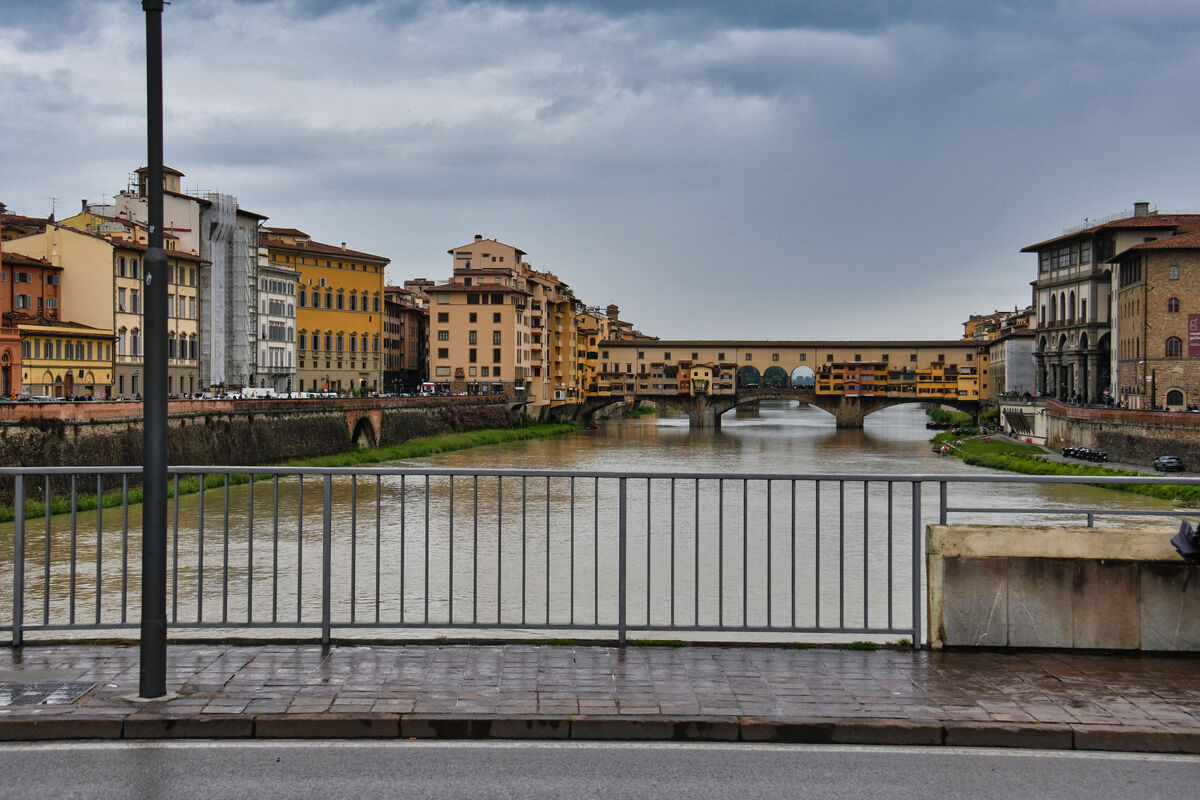
(Download)
Aug 1, 2023 15:43:38 #
Aug 1, 2023 15:49:06 #
Aug 1, 2023 15:53:48 #
Nice set!
Sadly, ALL days usually aren't sunny, but rain creates a different mood.
Sadly, ALL days usually aren't sunny, but rain creates a different mood.
Aug 1, 2023 16:04:21 #
srfmhg wrote:
The rain started early in the morning of our net d... (show quote)
Outstanding shots 🩶🖤🤍🖤🩶
Aug 1, 2023 16:23:39 #
Your choice of shots in the overcast is excellent, Mark! Wonderful street shots.
Aug 1, 2023 18:02:24 #
Aug 1, 2023 18:03:15 #
Longshadow wrote:
Nice set!
Sadly, ALL days usually aren't sunny, but rain creates a different mood.
Sadly, ALL days usually aren't sunny, but rain creates a different mood.
Thanks very much Bill. I love the look of wet cobblestones. More to come.
Aug 1, 2023 18:03:37 #
Aug 1, 2023 18:04:01 #
UTMike wrote:
Your choice of shots in the overcast is excellent, Mark! Wonderful street shots.
Thanks very much Mike.
Aug 1, 2023 22:03:53 #
srfmhg wrote:
The rain started early in the morning of our net d... (show quote)
Excellent set Mark. Florence is such a special place rain or shine. We got some rain on our 3 days there May 31- June 2, but it wasn't a problem, since we had compact umbrellas with us.
Aug 1, 2023 22:58:40 #
Aug 2, 2023 06:14:43 #
Aug 2, 2023 07:00:39 #
Wonderful set, Mark. You did capture the more normal, non-touristy, vibe of Florence. Beautifully done.
Aug 2, 2023 07:47:44 #
If you want to reply, then register here. Registration is free and your account is created instantly, so you can post right away.










